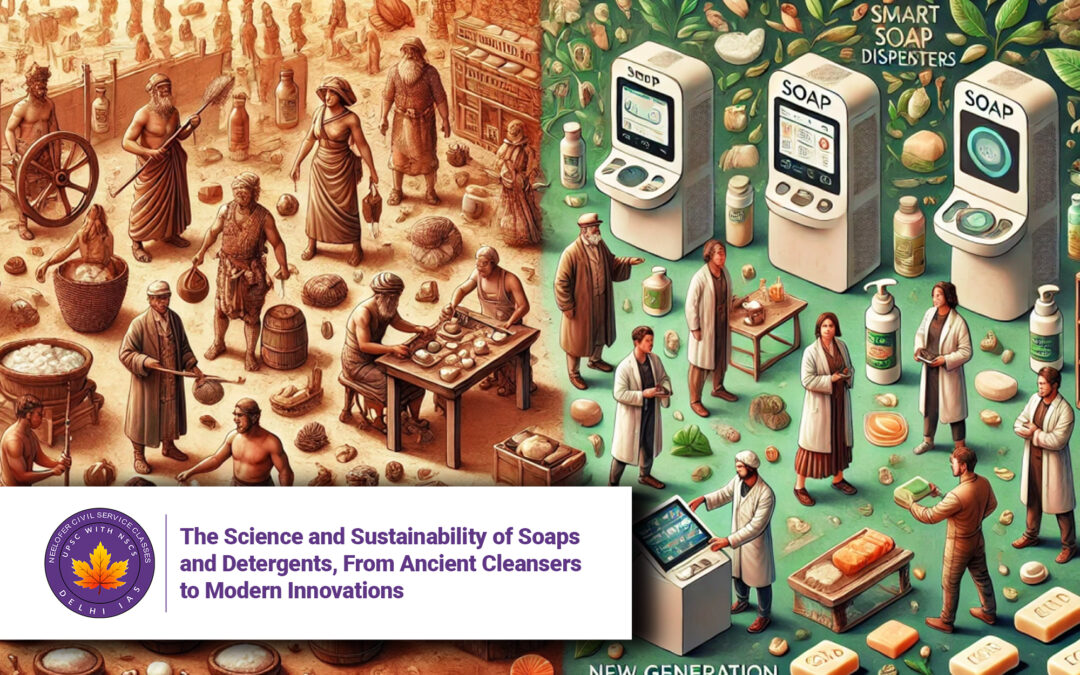The Science and Sustainability of Soaps and Detergents, From Ancient Cleansers to Modern Innovations
Introduction
From ancient Mesopotamian civilizations to today’s automated factories, soaps and detergents have evolved remarkably while remaining essential to human hygiene and sanitation. This article explores:
-
The chemistry behind soap production
-
Modern manufacturing processes
-
Environmental impacts of detergents
-
Emerging sustainable alternatives
-
5 Key Q&A on soap science
By examining these aspects, we uncover how an everyday product reflects both human ingenuity and ecological responsibility.
The Chemistry of Clean: How Soaps Work
Molecular Structure and Cleaning Action
-
Hydrophilic head (water-attracting)
-
Hydrophobic tail (oil-attracting)
-
Mechanism:
-
Tails embed in grease/oil
-
Heads remain in water
-
Scrubbing forms micelles
-
Rinsing removes dirt
-
Key Components
| Ingredient | Function | Example |
|---|---|---|
| Fatty acid salts | Base cleaner | Sodium palmitate |
| Surfactants | Reduce surface tension | Sodium lauryl sulfate |
| Perfumes | Fragrance | Sandalwood oil |
| Fillers | Bulk/texture | Talc |
From Oil to Bar: Modern Soap Manufacturing
Step-by-Step Production
-
Saponification
-
Triglycerides + NaOH → Glycerin + Soap
-
Temperature: 80-100°C
-
-
Drying & Extrusion
-
Vacuum drying removes moisture
-
Extruded as “noodles” (70-80% TFM)
-
-
Compounding
-
Additives: 5-15% of final product
-
Includes colors, perfumes, medicinals
-
-
Finishing
-
Plodding creates uniform bars
-
Stamping at 600-700 bars/minute
-
Quality Metrics
-
Total Fatty Matter (TFM)
-
Grade I: ≥76%
-
Grade II: 60-75%
-
Grade III: <60%
-
Detergents: The Synthetic Revolution
Historical Development
-
WWI shortages spurred synthetic alternatives
-
First commercial detergents: 1930s (Germany)
-
Key advantages:
-
Work in hard water
-
More powerful surfactants
-
Environmental Concerns
-
Phosphate buildup: Eutrophication
-
Non-biodegradable surfactants: Persistent pollution
-
Microplastic beads: Banned in many countries
Sustainable Innovations
Eco-Friendly Formulations
-
Plant-based surfactants
-
Coconut-derived alkyl polyglucosides
-
90% biodegradable in 28 days
-
-
Enzyme cleaners
-
Protease/lipase break down stains
-
Work at lower temperatures
-
-
Water-free alternatives
-
Solid shampoo bars
-
Concentrated detergent sheets
-
Manufacturing Advances
-
Cold-process soapmaking: 30% energy savings
-
AI-driven compounding: Reduces additive waste
-
Closed-loop water systems
5 Key Q&A on Soaps and Detergents
Q1: Why does soap lose effectiveness in hard water?
A: Calcium/magnesium ions form insoluble scum (calcium stearate), reducing active cleaning molecules.
Q2: What’s the difference between soap and detergent?
A: Soaps are natural fatty acid salts; detergents are synthetic surfactants with stronger cleaning power but greater environmental persistence.
Q3: How do “antibacterial” soaps work?
A: They contain additives like triclosan (now restricted) that disrupt microbial cell membranes. However, studies show plain soap is equally effective for routine hygiene.
Q4: Why are some people switching to soap nuts?
A: Soap nuts (Sapindus berries) contain natural saponins – a biodegradable alternative, though less effective for heavy cleaning.
Q5: What does the future hold for cleaning products?
A: Trends include:
-
Nano-cleaners: Targeted molecular cleaning
-
Probiotic cleaners: Beneficial bacteria compete with pathogens
-
Self-cleaning surfaces: Photocatalytic coatings
Conclusion: Cleaning Towards Sustainability
The soap industry stands at a crossroads between cleaning efficacy and environmental responsibility. As consumers increasingly prioritize eco-friendly products, manufacturers must balance:
Performance with biodegradability
Cost efficiency with sustainable sourcing
Hygiene benefits with microbiome protection







